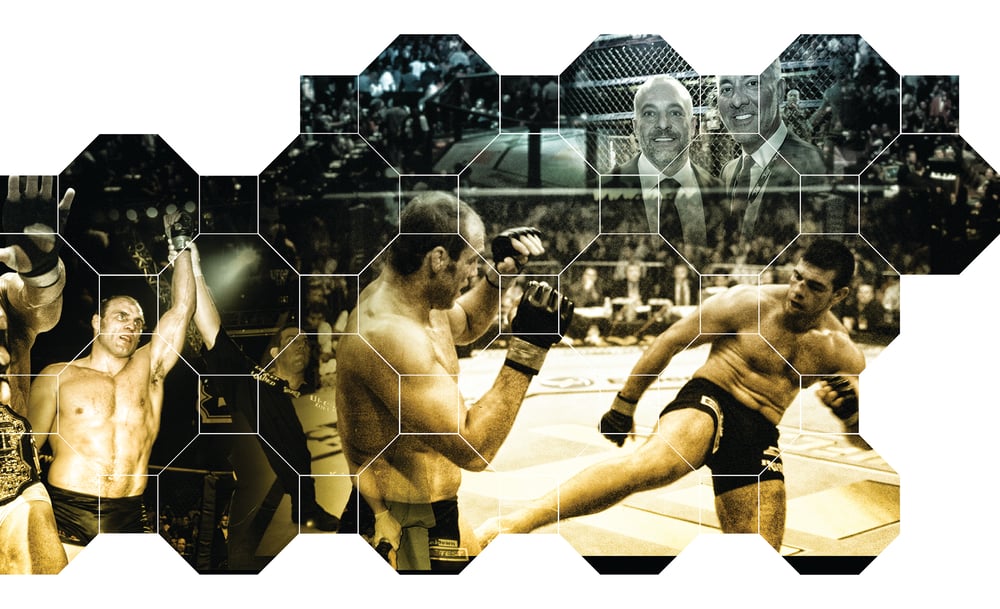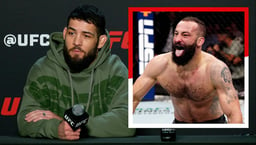
Issue 139
March 2016
It’s 15 years since Zuffa bought the Ultimate Fighting Championship and laid the groundwork for an MMA revolution. The company’s first year of ownership didn’t just lift the UFC out of the dark ages and toward a brighter future, it saved the entire sport. But it was far from smooth sailing…
A new beginning
“Welcome to Ultimate Fighting. Welcome to UFC 30.” It might not have seemed like it at the time, but the moment commentator Mike Goldberg first addressed the audience inside the Trump Taj Mahal in Atlantic City, New Jersey, on February 23rd, 2001, mixed martial arts entered a new era.
“Tonight signifies a new beginning,” continued Goldie. “With new leadership, tonight we promise you to take what is already the Super Bowl of mixed martial arts to a higher level, and someday – everyone will talk about the UFC as the premier sporting event in the world.”
This was the first event under the ownership of Lorenzo Fertitta, Frank Fertitta III and Dana White, following Zuffa, LLC’s $2 million acquisition of the UFC from Semaphore Entertainment Group (SEG). It was a time for optimism as it looked to escape the ‘Dark Ages’ of being shunned by PPV providers and home-video distributors. The promotion was about to take its first steps towards legitimizing mixed martial arts.
The Unified Rules of Mixed Martial Arts had been in place since UFC 28, but more steps forward would soon follow. “This is no longer that same spectacle of way back when,” promised color commentator and former Olympic wrestling gold medalist, Jeff Blatnick. “This is a sport, and Zuffa wants to make this one of the greatest sports in the world.”
The Zuffa stamp
UFC 30: Battle on the Boardwalk was far from a complete success. Zuffa inherited a struggling brand that was still exiled from most cable PPV carriers. The event’s live attendance was estimated at 3,000 with a paid gate of just $110,000, but even if the show wasn’t a financial success, it was a success in terms of spectacle.
The card featured five present and future UFC champions: Tito Ortiz, Evan Tanner, Jens Pulver, Josh Barnett and Sean Sherk. And the fights were great. The star of the show was Ortiz: the poster boy who slammed tough-as-nails Evan Tanner into unconsciousness after just 30 seconds to defend his 205lb (known as middleweight) belt.
As ‘The Huntington Beach Bad Boy’ left the cage and returned to his locker room, Goldberg remarked: “I truly think we saw the evolution of the sport begin, but we have to stress: this is only the beginning.” He was right. Though UFC 30 did well and became the first event since UFC 22 to have a home-video release, it couldn’t be described as a ‘real’ Zuffa production. It still showed fingerprints from the old SEG team – including matchmaker John Peretti.
White, the Fertittas and new matchmaker Joe Silva truly made their mark three months later in May with UFC 31, although many old faces remained, including Goldberg, Blatnick and Frank Shamrock on commentary duties. Bruce Buffer’s velvet voice meant he was also secure as ‘The Veteran Voice of the Octagon.’
But so much had a different look and feel. Production values on the broadcast took a leap forward. Audience interaction hit new heights as fans could log on to UFC.TV between rounds to vote for who they thought was winning fights, which really was a big deal at the time. Weight classes also adopted the current standard. For example, pre-UFC 31’s bantamweights became the 155lb lightweights we know and love, and middleweights morphed into today’s 205lb light heavyweights.
Even more apparent was the quality of the action. One of Lorenzo Fertitta’s philosophies was that every contest should feature fighters considered some of the best in the sport. The cards would be stacked, and this was one full deck. To this day, it remains one of Dana White’s favorite events. From the extraordinary debut of BJ Penn, Shonie Carter’s spinning back-fist on Matt Serra and Randy Couture’s five-round war for the ages with Pedro Rizzo, it was great.
The business side had a bit of catching up to do, but this was the UFC Zuffa had envisioned, and the blueprint it would take into the future.
Growing pains
Another significant step forward came at the next event. The promotion visited East Rutherford, New Jersey, and indicated the scale of its plans. It was an attempt to re-sell, re-brand and re-capture interest in a sport that had been ostracized. And Zuffa was going to throw some serious bills at this event to do it with a huge show in front of the largest media market in the world
An estimated $2.4 million was fired into the promotion in an attempt to attract the coveted 18-34 male demographic. Celebrities in attendance like Fred Durst of the band Limp Bizkit, Carmen Electra and Donald Trump were part of an unprecedented 12,500 people that packed into the Continental Airlines Arena.
Though the show ultimately lost money, UFC 32 was far from a failure. It was a statement of intent. It showed White, the Fertittas and co. were willing to take risks for huge reward, which was the sort of behavior that would launch them into the stratosphere in years to come. Need we mention The Ultimate Fighter?
Zuffa’s breakthrough should have come from the next event in September at UFC 33. Not only was it the first event to ever be sanctioned by the Nevada State Athletic Commission – paving the way for an organizational home in Las Vegas – the fights were back on pay-per-view. A promising 9,500 people attended the Mandalay Bay Events Center and 75,000 ordered the show, which was headlined by three title fights.
Unfortunately, it was an unmitigated disaster. All five main-card fights went the distance. Ortiz vs. Vladimir Matyushenko for the 205lb belt and Pulver vs. Dennis Hallman for 155lb gold were among the most uneventful title fights in history. Worse still, no one outside the arena saw the conclusion of the Ortiz fight because the broadcast ran over and cut out early on many cable systems. White has since described UFC 33 as “the worst show we’ve ever had.”
At least some lessons were learnt. There would never be three title fights on a main card again. The media was also assembled before the next show to publicize the fact that fighters would be stood up to break up prolonged periods of inactivity. This remains one of the most controversial parts of the Unified Rules of MMA, but it was seen as an essential step for Zuffa to avoid a repeat of this calamity and send a message to the PPV-buying pubic that the UFC was still worth their attention.
Light at the end of the tunnel
Zuffa hit the Vegas jackpot at November’s stacked follow-up with some historic MMA moments. Take your pick from Randy Couture vs. Ricco Rodriguez 2, Matt Hughes vs. Carlos Newton and Penn vs. Caol Uno for examples of jaw-dropping visions of violence at UFC 34. But another night of great fights didn’t mean Zuffa had a winning formula yet.
Throughout this period and beyond Zuffa introduced so much more than business advancements. It introduced elements that helped to show fighters’ personalities and connect with fans. Main-eventers finally had their own walkout music instead of the old UFC theme or Zack Tempest’s Loaded (aka the theme song for WWE’s The Hardy Boyz). Drama would be added to the moments before the fights through the introduction of face-offs, and weigh-ins became events in themselves.
There was a lot of trial and error. Not everything worked – bringing back faded veterans, experiments with the lightweight division, failure to hold on to champions – and Zuffa got burned a few times. But that’s the fight game. The North American MMA market wasn’t close to booming and there was guaranteed to be more than a few misses along with the hits as the march towards the mainstream picked up pace.
No one ever said it was going to be easy to turn the Ultimate Fighting Championship into the worldwide MMA leader. But the seeds of change had been sown in that first year. Spike TV, TUF, best-selling video games, international events and the Fox Network would follow in time. White and the Fertittas were the right guys at the right time in the right place to take the company forward to, eventually, become a worldwide phenomenon.
IN THE SPOTLIGHT
At the start of the UFC 30 show, broadcaster James Werme welcomed a shy, skinny figure onto camera. He wore a large black suit, stiff blue shirt buttoned all the way to the top, a tie wrapped tightly around his neck and a layer of dark, thinning hair that covered most of the top of his head. Believe it or not, this was Dana White. His appearance didn’t inspire the same confidence as modern-day president Dana, but he was committed to making the UFC the biggest brand in combat sports.
“I basically focused my whole life on this,” he told Fighters Only back in 2008. “My buddies, I got them to invest their money, and I was in on it. We knew exactly where we wanted to take it, what we needed to do and what we wanted to do, and that was running toward getting it regulated by all the major states. We knew that was the key.
“One thing we said that boxing had always done wrong was that all they cared about was what was on TV. We said, ‘What about the people buying tickets?’ We want to make it entertaining for them too. There were a lot of things we saw that needed to be changed, and we thought if we changed them it would make it a lot more exciting, a lot more entertaining and more buyable.”
PAYING $666K PER LETTER
With the UFC in a precarious position, not everyone thought it was a good idea to sink seven figures into a struggling brand. But chairman and CEO Lorenzo Fertitta was convinced he was spending his money on a sure-fire winner.
“I had my attorneys telling me that I was crazy because I wasn’t buying anything. I was paying $2 million and they were saying ‘What are you getting?’” Fertitta revealed to Fighters Only in 2009. “I said, ‘What you don’t understand is I’m getting the most valuable thing that I could possibly have, which is those three letters: UFC. That is what’s going to make this thing work. Everybody knows that brand. Whether they like it or they don’t like it, they react to it.’
“That’s what has tagged the sport. That’s branded the sport. People didn’t say, ‘I’m going to see an MMA fight,’ they said, ‘I want to see Ultimate Fighting.’ And I knew I had that asset and the library, the first 30 shows, and that’s what we bought.”











